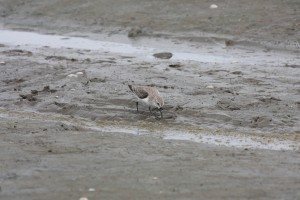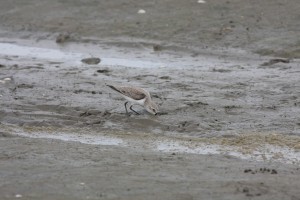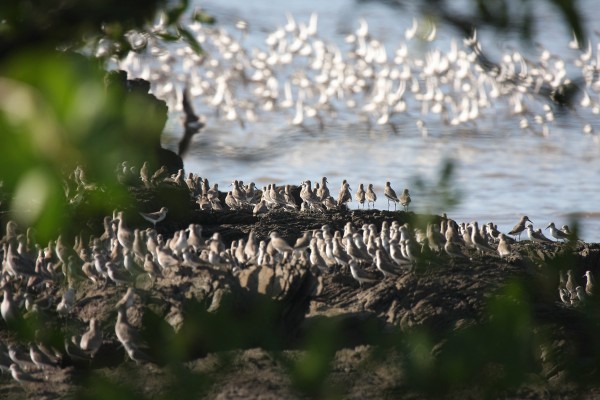Bay of Panama added to National Protected Areas (Ramsar Site)
Peregrine falcon, “James,” shatters record for lifetime reproductive success
January 7, 2009CCB Associate, Bill Portlock, honored by the Roger Tory Peterson Institute
January 9, 2009
Written by Bryan Watts
January 8, 2009
The Center for Conservation Biology (CCB) is excited to share news from our partners at Panama Audubon Society (PAS), that the wetlands of the Bay of Panama have been officially designated as a Protected Area under Panama’s National Protected Area System. For more than 11 years, the Panama Audubon Society has been working with global partners, including CCB researchers, to forward the conservation of this internationally important area for migratory shorebirds. The Bay of Panama was previously declared a Wetland of International Importance by the Ramsar Convention (2003), a globally recognized Important Bird Area (2003), and a Site of Hemispheric Importance by the Western Hemisphere Shorebird Reserve Network (WHSRN) (2005). The status of Protected Area under the Panamanian government gives additional legal framework for long-term conservation to more than 200,000 acres of wetlands in the Bay of Panama.

Shorebirds flock in the Bay of Panama mudflats, which stretch-out in view of Panama City. Photo by Bart Paxton.
The newly Protected Area, known as the ‘Wetland of International Importance of the Bay of Panama’ or the ‘Ramsar Site Bay of Panama,’ is East of Panama City on the Pacific coast, featuring vast intertidal mudflats crossed by several estuaries, mangrove forests, swamp forests, and freshwater pools. It is renowned as an important stopover for migrating shorebirds: over 3 days in 2008, CCB counted and mapped more than 490,000 individual shorebirds, seabirds, herons and egrets, and it is estimated that more than 2 million birds stop there during migration. The site harbors over 8% of the world population of Western Sandpipers (Calidris mauri) with records of over 280,000 birds, 20% of Semipalmated Plover (Charadrius semipalmatus), and over 1% of the biogeographical populations of Semipalmated Sandpiper (Calidris pusilla), Willet (Catoptrophorus semipalmatus), Whimbrel (Numenius phaeopus), Short-billed Dowitcher (Limnodromus griseus) and the Black-bellied (aka Grey) Plover (Pluvialis squatarola). Endangered species in the area include the Giant Anteater (Myrmecophaga tridactyla), Baird’s Tapir (Tapirus bairdii), American Crocodile (Crocodylus acutus), Loggerhead Turtle (Caretta caretta) and the endemic tree species (Annona spreguei). (International Mire Conservation Group Newsletter, 2003, no.4) The main human activities in the area are fishing and agriculture, but due to its proximity to Panama City, pressures from urban development are increasing, as well as pollution from sewage waters discharged into the sea.

A western sandpiper forages in the mudflats of Panama Bay. Photo by Bart Paxton.

A western sandpiper forages in the mudflats of Panama Bay. Photo by Bart Paxton.
CCB is proud to have played a part in bringing international conservation attention to the region by providing baseline and follow-up data on Panama Bay’s shorebird populations. In 1997, the Center for Conservation Biology conducted a systematic investigation of the waterbirds in the greater Bay of Panama, funded by the US Department of Defense Legacy Program and the Smithsonian Tropical Research Institute, and in cooperation with PAS, contributing benchmark data to the conservation effort. (See CCB’s Summer 2008 article: Fall 2008 return to upper Bay of Panama to reassess migrant shorebirds.) In October 2008, CCB conducted a follow-up survey to reassess the region, finding that several key estuaries in the Upper Bay of Panama supported 98% of the waterbirds detected. (See CCB’s October-December 2008 article: Aerial survey of the Pacific coast of Panama for waterbirds completed.)

Shrimp farms adjacent to mangroves in Panama Bay – Shrimp farming is one type of development encroaching on wetlands of Panama Bay. Photo by Bart Paxton.
CCB’s research efforts in 1997 and 2008 were among several projects and activities around and within the site that furthered its conservation. PAS has conducted many newspaper and magazine interviews, in order to raise the awareness of all Panamanians of the important role the Bay of Panama wetlands play in the annual migration of migratory shorebirds, in protecting local communities against adverse climate-related conditions, and in providing nursery areas for many species of commercially important fish and shrimp, among other ecosystem services.
“This was a team effort,” said Rosabel Miró, Panama Audubon Society Executive Director and Ramsar’s NGO National Coordinator for Communication, Education, Participation and Awareness. “An alliance among Non-Governmental Organizations (NGOs), the government, and individuals for the protected area designation of the wetlands of the Bay of Panama was born and paid good dividends. To all of you our message is simple: let us continue finding ways to collaborate for the conservation and protection of this magnificent site!”

A flock of mostly western sandpipers on a tidal rock outcropping, framed by mangroves. Photo by Bart Paxton.
Project sponsored by The Center for Conservation Biology (CCB), U.S. Dept. of Defense Partners In Flight (DOD PIF), and Panama Audubon Society (PAS).
About Ramsar: The Ramsar Convention (The Convention on Wetlands of International Importance, especially as Waterfowl Habitat) is an international treaty that provides the framework for national action and international cooperation for the conservation and sustainable utilization of wetlands, i.e., to stem the progressive encroachment on and loss of wetlands now and in the future, recognizing the fundamental ecological functions of wetlands and their economic, cultural, scientific, and recreational value. It is named for the Iranian city of Ramsar, where it was adopted in 1971, and is the only global environmental treaty that deals with a particular ecosystem. The Convention’s member countries cover all geographic regions of the planet. The Convention’s mission is “the conservation and wise use of all wetlands through local, regional and national actions and international cooperation, as a contribution towards achieving sustainable development throughout the world.”
About WHSRN: The Western Hemisphere Shorebird Reserve Network was launched in 1985, as a hemispheric-scale voluntary conservation collaborative strategy to protect key habitats throughout the Americas in order to sustain healthy populations of shorebirds. During the last 20 years, over 22 million acres of shorebird habitat, comprised of 70 sites in 10 nations, has been brought under the auspices of WHSRN.




